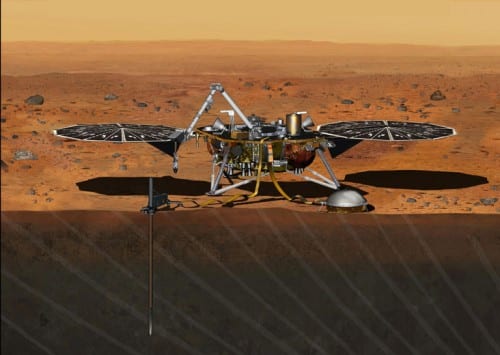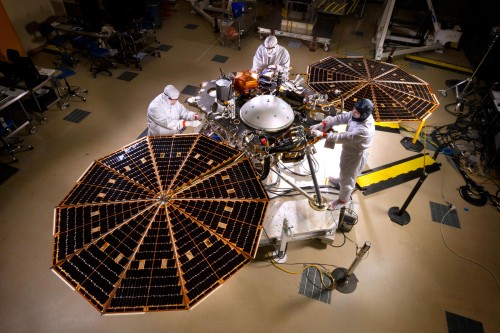The meaning of the postponement - a postponement of 26 months until the next launch window when the two planets will be close together* The person who will take advantage of the window will be the European Space Agency with the first part of the exo-Mars probe

NASA Has announced today that it decided to postpone the launch of the InSight lander mission scheduled for March 2016, due to a leak in the vacuum counter in which the lander's seismograph, built by the French Space Agency (CNES), is located. As a result, the narrow launch window in which the optimal journey between Earth and Mars is possible will be missed - once every 26 months, when the two planets are close to each other in their orbits - and the mission will likely be postponed until the next launch window, around May 2018, a senior NASA official said at a party journalists held by the agency today, although the agency did not specifically say what would happen to the mission.
The "InSight" mission, which stands for Interior Exploration using Seismic Investigations Geodesy and Heat Transport, or InSight for short, is a lander to Mars that is identical in design to the "Phoenix" lander that was launched to Mars in 2008. The geological mission was designed to study the internal structure of Mars , in order to better understand the initial processes that shaped the terrestrial planets (Hema, Venus, Earth and Mars). According to the mission site, "Mars is large enough to undergo the initial processes of internal heating and differentiation (the separation between the planet's crust, mantle and core) that shaped the terrestrial planets, but small enough to preserve the imprint of these processes for 4 billion years." This is in contrast, for example, to the Earth, where processes such as plate tectonics have left no traces of those ancient processes.
The two central scientific instruments in the mission are an extremely sensitive seismograph capable of detecting displacements in the earth up to the diameter of a single atom, and a device known as a "mole", whose job is to dig a few meters into the earth to measure the emission of heat from the core of Mars.
The fault that caused the mission to be postponed is a leak in the vacuum counter that contains the seismograph (which includes three different seismographs). The seismograph (SEIS) was not built by NASA but by the French Space Agency (CNES), which cooperates with NASA in this mission. The seismograph sensors themselves are perfectly fine, but due to the leak (admittedly only tiny) in the vacuum that is supposed to protect them from the harsh and extreme conditions on the surface of Mars, the component loses its scientific credibility.
The first leak in the seismograph's vacuum count was reported Already at the beginning of the month, the French Space Agency and NASA said that the leak would be treated and sealed, and that the mission should meet the tight schedule. That leak was indeed plugged, but other leaks have since been discovered. The final decision to postpone the launch was only made on Monday, due to another leak that was discovered and the realization that the problem of vacuum leaks must be more precisely addressed and that it would not be possible to solve the problem in time for the 2016 launch window.
Just a few days ago, on December 16, the built probe was sent to the Vandenberg Air Force base in California, from where the launch was planned, and now it will be returned to the base of the Lockheed Martin company in Denver, where, apparently, it will wait for the next launch window. The InSight mission is part of NASA's Discovery program, which includes relatively "low" cost research missions, and the total cost was assessed by a senior NASA official for $675 million.

It is worth noting that if launched, the InSight mission would not be the first to place a seismograph on Mars. Seismographs were already sent in 1975 aboard the Viking landers, the first successful landings on Mars in the history of space exploration. Only in Viking 2 did the seismograph work successfully, but it was mounted on the lander itself and was affected by winds, so His data is questionable. In "Insight", on the other hand, a robotic arm will place the seismograph (as well as the "mole" device) on the ground, in addition to being protected from external factors such as wind.
Meanwhile, and despite the postponement of the InSight launch in March of next year, we will still see the launch of a lander and a probe to Mars in the same month, as part of the first part of the mission Exo-Mars The European one, which is done in cooperation with Russia. The current mission will include a satellite that will investigate the methane gas that is found in a tiny amount in the atmosphere of Mars, but since it is not stable there for long, there should be a source that renews it, most likely a geological source, but it could be biological. The mission will also include a small lander, named Skiparelli, which will serve as a demonstration of the landing technology for the second part of the Exo Mars mission in 2018, in which a robotic rover will be launched towards Mars. Skiparelli will only operate for a few days on the surface of Mars until its batteries run out.

3 תגובות
Israel should take advantage of the opportunity and send people to Mars.
What a blunder by the French, they should have given the job to the Israelis. We are much better when it comes to high-tech equipment.